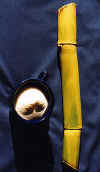SUGAR
 Sugar was first used by humans as a natural and necessary
constituent in our plant and meat foods. Later, honey from wild bees would be sought out
by humans as a special treat. As farming involves us with domestic plants humans identify
and use various plants to produce sugar; such as sugar
maple, sugar beet, sugar palm, sweet sorghum, and sweet corn. Sugarcane
(Saccharum officinarum) is the most important source of sucrose (C12H22O11) in world
history and especially in the Columbian Exchange. Sugarcane was originally developed and
domesticated in New Guinea about 10,000 years ago. By A.D. 700 sugarcane had diffused to
the Mediterranean region by Islamic expansion and trade. Sugarcane sucrose had been viewed
as an exotic spice and medicine, but by A.D. 1000,with the crusades Europe, will develop a
broader appetite for sugar in many foods. In the 1500's Spain and Portugal will begin
sugarcane production in the milder Atlantic Islands such as the Canary Islands and Sao
Tome'.
Sugar was first used by humans as a natural and necessary
constituent in our plant and meat foods. Later, honey from wild bees would be sought out
by humans as a special treat. As farming involves us with domestic plants humans identify
and use various plants to produce sugar; such as sugar
maple, sugar beet, sugar palm, sweet sorghum, and sweet corn. Sugarcane
(Saccharum officinarum) is the most important source of sucrose (C12H22O11) in world
history and especially in the Columbian Exchange. Sugarcane was originally developed and
domesticated in New Guinea about 10,000 years ago. By A.D. 700 sugarcane had diffused to
the Mediterranean region by Islamic expansion and trade. Sugarcane sucrose had been viewed
as an exotic spice and medicine, but by A.D. 1000,with the crusades Europe, will develop a
broader appetite for sugar in many foods. In the 1500's Spain and Portugal will begin
sugarcane production in the milder Atlantic Islands such as the Canary Islands and Sao
Tome'.
However, a much larger scale production of sugarcane shifts across the Atlantic to
America with the introduction of sugarcane to Santo Domingo on Columbus' second voyage in
1493. Eventually, America will surpass Mediterranean sugarcane industry as huge
plantations will spread to Cuba, Puerto Rico, and Jamaica. Sugarcane also made inroads
with indigo in the Portuguese colony of Brazil. In conjunction with industrialization in
Europe the habit of sugar consumption with coffee, tea, and rum will become a
drug-like addiction involving sugar, alcohol, and tobacco. Europeans and eventually
the world, as it industrializes, will, without much alarm or perceptions of dangers of
abuse, feed one of the largest cash crops and food businesses in the world. Cacao like tea
and coffee contains a stimulant and is combined with vanilla , milk products, and sugar to
produce a sweet with supposed aphrodisiac properties called chocolate this is only one
aspect of sugars impact and importance.
The initial labor for sugarcane plantations in America will fall on Native Americans,
but by 1600 95 % of Native Americans in the Caribbean and Atlantic Coast populations will
be dead, mainly due to disease and labor. African slavery will replace the Native American
slave labor and by 1888 9.5 million African people will be enslaved in the Americas. The
Caribbean plantations will dominate in sugarcane and slaves, but Portuguese Brazil will
always be a strong competitor to the Spanish and other Europeans in the Caribbean. The
Southeastern United States in colonial times and as part of the United States will
also operate plantations dominated with sugarcane and sorghum production of sugar. The
cruelty and exploitation of these slave plantation systems will, driven by unprecedented
greed, bring the entire African slave trade aspect to a halt by the late 1880s. In the
case of French Haiti (called Saint Dominique) 450,000 African slaves will be
persecuted so that a bloody fifteen year revolt will result in the only full take over of
a colony in America by African slaves.
After the abolishment of slavery and emancipation the need for labor continued due to
the fact that the plantation system was too lucrative to abandon. Many freed slaves were
hired at low wages, but thousands of new laborers were brought in from India, China, and
S.E. Asia to the sugarcane plantations in the Americas. This, of course, explains the
tremendous cultural mix of European, African, and Asian peoples, especially in the
Caribbean. The original Native Americans of the Caribbean islands have mostly melted into
the immigrant populations, but a few communities on the islands maintain their roots, e.g.
Taino or Carib peoples who's ancestors actually greeted and initially aided Columbus in
1492.
So sugarcane was a major component of the Columbian Exchange and unfortunately the
principle commodity for stimulating the American slave trade. Today, English and Americans
are still the highest consumers of sugar (more than 120 lbs. per person per year), more
than any other people on earth. The medical repercussions of this are just being
recognized with sugar metabolism problems, alcoholism, and dental problems being just the
tip of the iceberg. Today, a great deal of sucrose is derived from corn syrup and recently
grape fructose. Rather than reducing our desire for sweet tastes, we have developed a
whole new stimulus for the chemical production of artificial sweeteners, like saccharine,
aspartame, and cyclamates.

Copyright �
S.J. Crouthamel
 Sugar was first used by humans as a natural and necessary
constituent in our plant and meat foods. Later, honey from wild bees would be sought out
by humans as a special treat. As farming involves us with domestic plants humans identify
and use various plants to produce sugar; such as sugar
maple, sugar beet, sugar palm, sweet sorghum, and sweet corn. Sugarcane
(Saccharum officinarum) is the most important source of sucrose (C12H22O11) in world
history and especially in the Columbian Exchange. Sugarcane was originally developed and
domesticated in New Guinea about 10,000 years ago. By A.D. 700 sugarcane had diffused to
the Mediterranean region by Islamic expansion and trade. Sugarcane sucrose had been viewed
as an exotic spice and medicine, but by A.D. 1000,with the crusades Europe, will develop a
broader appetite for sugar in many foods. In the 1500's Spain and Portugal will begin
sugarcane production in the milder Atlantic Islands such as the Canary Islands and Sao
Tome'.
Sugar was first used by humans as a natural and necessary
constituent in our plant and meat foods. Later, honey from wild bees would be sought out
by humans as a special treat. As farming involves us with domestic plants humans identify
and use various plants to produce sugar; such as sugar
maple, sugar beet, sugar palm, sweet sorghum, and sweet corn. Sugarcane
(Saccharum officinarum) is the most important source of sucrose (C12H22O11) in world
history and especially in the Columbian Exchange. Sugarcane was originally developed and
domesticated in New Guinea about 10,000 years ago. By A.D. 700 sugarcane had diffused to
the Mediterranean region by Islamic expansion and trade. Sugarcane sucrose had been viewed
as an exotic spice and medicine, but by A.D. 1000,with the crusades Europe, will develop a
broader appetite for sugar in many foods. In the 1500's Spain and Portugal will begin
sugarcane production in the milder Atlantic Islands such as the Canary Islands and Sao
Tome'.